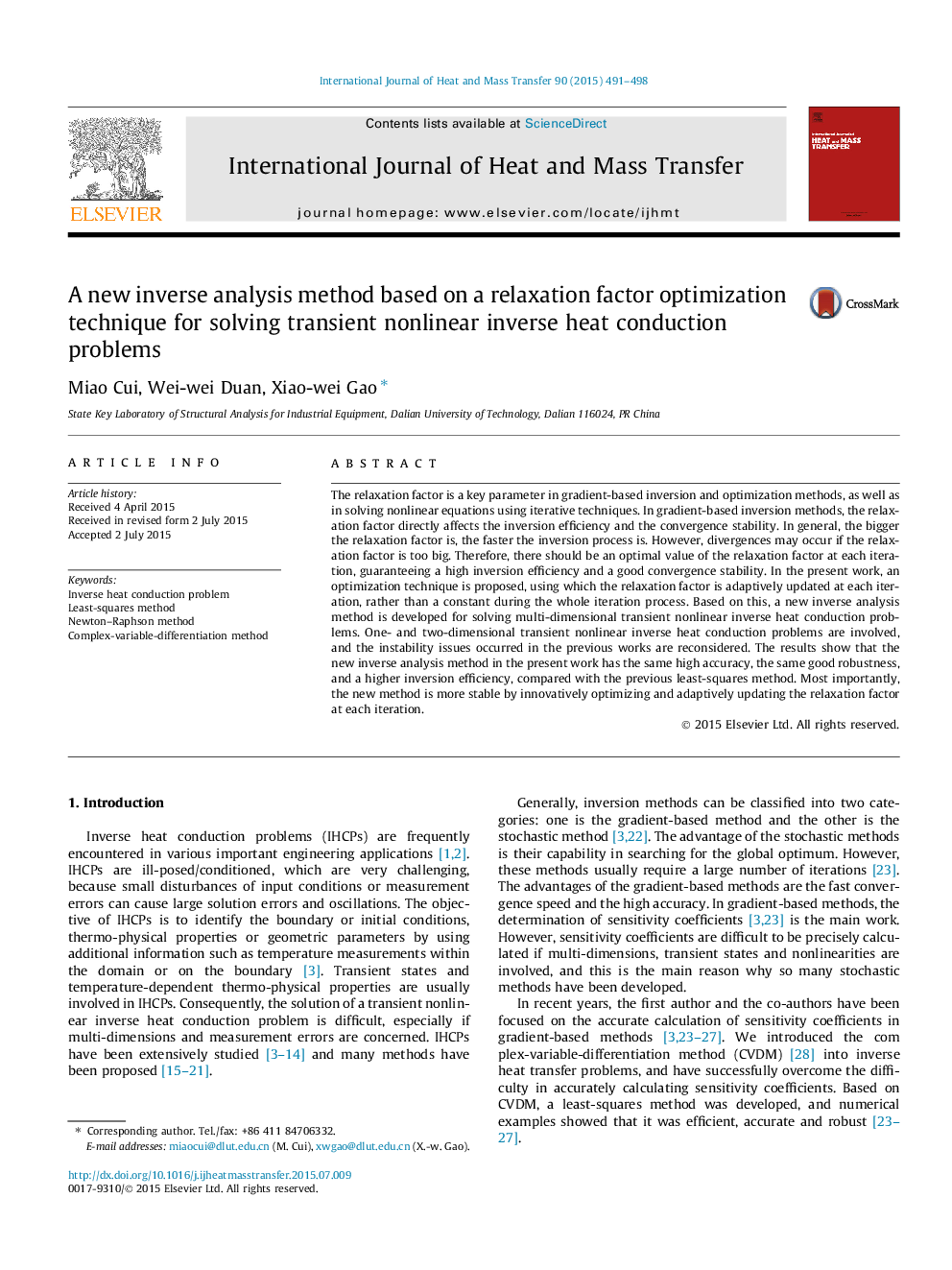| کد مقاله | کد نشریه | سال انتشار | مقاله انگلیسی | نسخه تمام متن |
|---|---|---|---|---|
| 7056456 | 1458052 | 2015 | 8 صفحه PDF | دانلود رایگان |
عنوان انگلیسی مقاله ISI
A new inverse analysis method based on a relaxation factor optimization technique for solving transient nonlinear inverse heat conduction problems
ترجمه فارسی عنوان
یک روش آنالیز معکوس جدید مبتنی بر تکنیک بهینه سازی فاکتور آرام سازی برای حل مسائل انتقال حرارت غیرخطی انتقال معکوس است
دانلود مقاله + سفارش ترجمه
دانلود مقاله ISI انگلیسی
رایگان برای ایرانیان
کلمات کلیدی
ترجمه چکیده
فاکتور آرامش پارامتر کلیدی در روشهای معکوس و بهینه سازی مبتنی بر شیب، و همچنین در حل معادلات غیر خطی با استفاده از تکنیک های تکراری است. در روش های معکوس مبتنی بر شیب، عامل آرام سازی به طور مستقیم بر کارایی معکوس و ثبات همگرایی تاثیر می گذارد. به طور کلی، فاکتور آرامش بزرگتر، سریعتر روند فرار است. با این حال، اختلافات ممکن است رخ دهد اگر فاکتور آرامش بیش از حد بزرگ باشد. بنابراین، در هر تکرار یک ارزش مطلوب فاکتور آرامش وجود دارد، که یک بازده بالا معکوس و ثبات یکپارچگی خوب را تضمین می کند. در این مقاله، یک تکنیک بهینه سازی پیشنهاد شده است که با استفاده از آن فاکتور آرامش در هر تکرار به صورت سازگار به روز می شود، نه یک ثابت در طول روند تکرار. بر این اساس، یک روش آنالیز معکوس جدید برای حل مسئله انتقال حرارت غیرمستقیم چند بعدی از نظر هدایت گرمایشی ایجاد شده است. مشکلات مربوط به هدایت گرما معکوس غیر خطی یکسو و دو بعدی درگیر هستند و مسائل بی ثباتی در آثار قبلی نیز در حال بررسی است. نتایج نشان می دهد که روش تجزیه و تحلیل جدید معکوس در این مقاله دقت بالا، همان قدرت خوب و بازده بالاتر معکوس دارد، در مقایسه با روش کمترین مربع قبلی. مهمتر از همه، روش جدید با نوآوری بهینه سازی و تطبیقی به روز رسانی عامل آرامش در هر تکرار پایدار است.
موضوعات مرتبط
مهندسی و علوم پایه
مهندسی شیمی
جریان سیال و فرایندهای انتقال
چکیده انگلیسی
The relaxation factor is a key parameter in gradient-based inversion and optimization methods, as well as in solving nonlinear equations using iterative techniques. In gradient-based inversion methods, the relaxation factor directly affects the inversion efficiency and the convergence stability. In general, the bigger the relaxation factor is, the faster the inversion process is. However, divergences may occur if the relaxation factor is too big. Therefore, there should be an optimal value of the relaxation factor at each iteration, guaranteeing a high inversion efficiency and a good convergence stability. In the present work, an optimization technique is proposed, using which the relaxation factor is adaptively updated at each iteration, rather than a constant during the whole iteration process. Based on this, a new inverse analysis method is developed for solving multi-dimensional transient nonlinear inverse heat conduction problems. One- and two-dimensional transient nonlinear inverse heat conduction problems are involved, and the instability issues occurred in the previous works are reconsidered. The results show that the new inverse analysis method in the present work has the same high accuracy, the same good robustness, and a higher inversion efficiency, compared with the previous least-squares method. Most importantly, the new method is more stable by innovatively optimizing and adaptively updating the relaxation factor at each iteration.
ناشر
Database: Elsevier - ScienceDirect (ساینس دایرکت)
Journal: International Journal of Heat and Mass Transfer - Volume 90, November 2015, Pages 491-498
Journal: International Journal of Heat and Mass Transfer - Volume 90, November 2015, Pages 491-498
نویسندگان
Miao Cui, Wei-wei Duan, Xiao-wei Gao,
